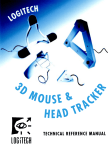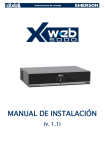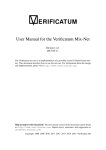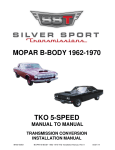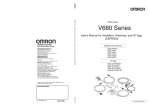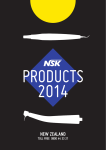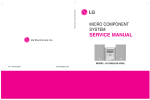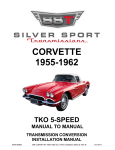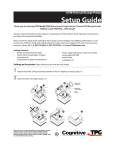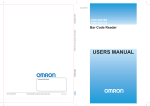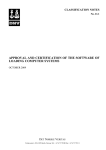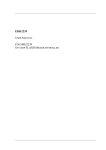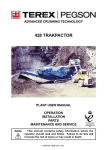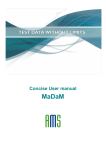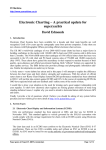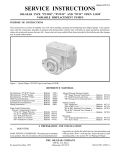Download Ch.9 Survey requirements
Transcript
RULES FOR CLASSIFICATION
Ships
Edition October 2015
Part 6 Additional class notations
Chapter 9 Survey requirements
The content of this service document is the subject of intellectual property rights reserved by DNV GL AS ("DNV GL"). The user
accepts that it is prohibited by anyone else but DNV GL and/or its licensees to offer and/or perform classification, certification
and/or verification services, including the issuance of certificates and/or declarations of conformity, wholly or partly, on the
basis of and/or pursuant to this document whether free of charge or chargeable, without DNV GL's prior written consent.
DNV GL is not responsible for the consequences arising from any use of this document by others.
The electronic pdf version of this document, available free of charge
from http://www.dnvgl.com, is the officially binding version.
DNV GL AS
FOREWORD
DNV GL rules for classification contain procedural and technical requirements related to obtaining
and retaining a class certificate. The rules represent all requirements adopted by the Society as
basis for classification.
©
DNV GL AS October 2015
Any comments may be sent by e-mail to [email protected]
If any person suffers loss or damage which is proved to have been caused by any negligent act or omission of DNV GL, then DNV GL shall
pay compensation to such person for his proved direct loss or damage. However, the compensation shall not exceed an amount equal to ten
times the fee charged for the service in question, provided that the maximum compensation shall never exceed USD 2 million.
In this provision "DNV GL" shall mean DNV GL AS, its direct and indirect owners as well as all its affiliates, subsidiaries, directors, officers,
employees, agents and any other acting on behalf of DNV GL.
Part 6 Chapter 9 Changes - current
CHANGES – CURRENT
This is a new document.
The rules enter into force 1 January 2016.
Rules for classification: Ships — DNVGL-RU-SHIP-Pt6Ch9. Edition October 2015
Survey requirements
DNV GL AS
Page 3
Changes – current...................................................................................................... 3
Section 1 Ships built for in-water survey of the ship's bottom and related items BIS..........................................................................................................................7
1 General.................................................................................................. 7
1.1 Introduction....................................................................................... 7
1.2 Scope................................................................................................. 7
1.3 Application.......................................................................................... 7
1.4 Class notations.................................................................................... 7
2 Procedural requirements........................................................................ 7
2.1 Documentation requirements................................................................. 7
3 Design requirements.............................................................................. 8
3.1 Onboard documentation........................................................................ 8
3.2 Markings of ship’s sides and bottom....................................................... 8
3.3 Rudder................................................................................................8
3.4 Tailshaft.............................................................................................. 8
3.5 Thrusters............................................................................................ 9
Section 2 Enhanced survey program - ESP...............................................................10
1 General................................................................................................ 10
1.1 Introduction..................................................................................... 10
1.2 Scope............................................................................................... 10
1.3 Application.........................................................................................10
2 ESP ships.............................................................................................. 10
2.1 Oil tankers........................................................................................ 10
2.2 Bulk Carriers......................................................................................10
2.3 Ore Carriers.......................................................................................11
2.4 Chemical tankers................................................................................12
Section 3 Hull life cycle programme - HLP............................................................... 13
1 General................................................................................................. 13
1.1 Introduction....................................................................................... 13
1.2
Scope.............................................................................................. 13
1.3 Application.........................................................................................13
1.4 Procedure.......................................................................................... 13
Section 4 Hull monitoring systems - HMON..............................................................14
Rules for classification: Ships — DNVGL-RU-SHIP-Pt6Ch9. Edition October 2015
Survey requirements
DNV GL AS
Page 4
Part 6 Chapter 9 Contents
CONTENTS
1.1 Introduction....................................................................................... 14
1.2 Scope............................................................................................... 14
1.3 Application.........................................................................................14
1.4 Definitions......................................................................................... 15
1.5 Documentation requirements............................................................... 16
2 Component requirements......................................................................18
2.1 Component requirements.................................................................... 18
2.2 Sensors............................................................................................. 18
2.3 Signal conditioning units..................................................................... 19
3 System design...................................................................................... 19
3.1 System requirements.......................................................................... 19
3.2 Primary elements............................................................................... 20
3.3 Data processing................................................................................. 23
3.4 User interfaces...................................................................................27
3.5 Data storage......................................................................................28
3.6 Extent of monitoring...........................................................................28
4 Installation and testing........................................................................ 30
4.1 General............................................................................................. 30
4.2 Approval and testing procedure............................................................31
Section 5 Tailshaft monitoring - TMON.....................................................................32
1 General................................................................................................. 32
1.1 Introduction....................................................................................... 32
1.2 Scope............................................................................................... 32
1.3 Application.........................................................................................32
1.4 Documentation requirements............................................................... 32
2 Design requirements.............................................................................32
2.1 General............................................................................................. 33
2.2 Oil quality monitoring......................................................................... 33
2.3 Roller bearings arranged in the stern tube.............................................33
2.4 Monitoring......................................................................................... 34
3 Testing.................................................................................................. 34
3.1 Application.........................................................................................34
Section 6 Boiler monitoring - BMON.........................................................................35
1 General................................................................................................. 35
1.1 Introduction....................................................................................... 35
1.2 Scope............................................................................................... 35
Rules for classification: Ships — DNVGL-RU-SHIP-Pt6Ch9. Edition October 2015
Survey requirements
DNV GL AS
Page 5
Part 6 Chapter 9 Contents
1 General................................................................................................. 14
1.4 Documentation requirements............................................................... 36
1.5 Initial survey..................................................................................... 37
Rules for classification: Ships — DNVGL-RU-SHIP-Pt6Ch9. Edition October 2015
Survey requirements
DNV GL AS
Page 6
Part 6 Chapter 9 Contents
1.3 Application.........................................................................................35
1 General
1.1 Introduction
The additional class notation BIS applies to vessel's which has been prepared for in-water survey of the
vessel's outside, which includes the openings in sides and bottom below the deepest load water line, bottom
plugs, echo sounders and other underwater equipment.
1.2 Scope
The rules in this section give requirements for the markings of vessel's sides and bottom, rudder bearings,
and survey requirements for tail shaft(s) and thruster(s).
1.3 Application
The additional class notation BIS indicates that the vessel is prepared for in-water survey. The conditions
under which in-water survey is allowed are given in Pt.7 Ch.1 Sec.1. Means should be provided to enable the
diver to confirm that the sea suction openings are clear. Hinged sea suction grids will facilitate this operation,
preferably with revolving weight balance or with a counter weight, and secured with fitting while the ship is
afloat.
1.4 Class notations
1.4.1 BIS
Ships built in compliance with the requirements as specified in Table 1 will be assigned the additional notation
related to survey arrangement:
Table 1 Additional class notation related to survey arrangement - BIS
Class Notation
Qualifier
Purpose
Application
<None>
Built for in-water survey of
the ship’s bottom and related
items
BIS
Mandatory:
No
Design requirements:
[3]
FiS requirements:
N.A.
2 Procedural requirements
2.1 Documentation requirements
2.1.1 BIS
Documentation shall be submitted as required by Table 2.
Rules for classification: Ships — DNVGL-RU-SHIP-Pt6Ch9. Edition October 2015
Survey requirements
DNV GL AS
Page 7
Part 6 Chapter 9 Section 1
SECTION 1 SHIPS BUILT FOR IN-WATER SURVEY OF THE SHIP'S
BOTTOM AND RELATED ITEMS - BIS
Object
Documentation type
Additional description
Info
Hull structure
Z030 – Arrangement plan
Openings in sides and bottom below the
deepest load waterline, bottom plugs,
echo sounders and other underwater
equipment.
FI
Bottom survey marks
Z030 – Arrangement plan
Markings for identification of tanks on
sides and bottom.
AP
Rudder arrangements
Z250 – Procedure
Measurement of bearing clearances.
FI
Impressed current system
Z030 – Arrangement plan
FI
AP = For approval; FI = For information ACO = As carried out; L = Local handling; R = On request; TA = Covered by
type approval; VS = Vessel specific
3 Design requirements
3.1 Onboard documentation
The documentation required by Table 2 shall be available onboard.
3.2 Markings of ship’s sides and bottom
3.2.1 The underwater body shall be marked in such a way that the surveyor can identify the location of any
observations made. Transverse and longitudinal reference lines of approximate length 300 mm and width
25 mm shall be applied as marking. The marks shall be made permanent welding or similar and painted in a
contrasting colour.
Marking shall normally be placed as follows:
— At flat bottom in way of intersections of tank bulkheads or watertight floors and girders.
— At ship’s sides in way of the positions of transverse bulkheads (the marking need not be extended more
than 1 m above bilge plating).
— The intersection between tank top and watertight floors in way of ship’s sides.
— All openings for sea suctions and discharge.
— Letter and number codes shall be applied on the shell for identification of tanks, sea suctions and
discharges.
3.3 Rudder
3.3.1 Bearing materials shall be stainless steel, bronze or an approved type of synthetic material and shall
satisfy the requirements in Pt.3 Ch.14 Sec.1.
3.3.2 For water lubricated bearings, arrangements shall be made for measuring of rudder stock and pintle
clearances while the ship is afloat.
3.4 Tailshaft
3.4.1 The tailshaft shall be designed to minimum 5 years survey interval, ref. Pt.7 Ch.1 Sec.1 [1].
Rules for classification: Ships — DNVGL-RU-SHIP-Pt6Ch9. Edition October 2015
Survey requirements
DNV GL AS
Page 8
Part 6 Chapter 9 Section 1
Table 2 Documentation requirements forclass notation BIS
3.5.1 Thrusters shall have 5 year survey interval or alternatively the reduced scope survey, as required in
Pt.7 Ch.1 Sec.5 [4] /Pt.7 Ch.1 Sec.5 [5], shall be possible while the ship is afloat.
Rules for classification: Ships — DNVGL-RU-SHIP-Pt6Ch9. Edition October 2015
Survey requirements
DNV GL AS
Page 9
Part 6 Chapter 9 Section 1
3.5 Thrusters
1 General
1.1 Introduction
The additional class notation ESP applies to ships covered by SOLAS Ch. XI-1 - "Special measures to
enhance maritime safety" and refer to Pt.7 Ch.1. The notation is mandatory for these ship types and gives
requirements and guidelines for an enhanced survey programme.
1.2 Scope
The rules in this section give requirements for the different ship types, which includes a description of the
types of construction, for which the additional class notation ESP is mandatory.
1.3 Application
The additional class notation ESP is applicable for oil tankers, bulk carriers, ore carriers and chemical
tankers, as covered by SOLAS Ch. XI-1 - "Special measures to enhance maritime safety". Further details
about the requirements and guidelines for ESP are described in Pt.7 Ch.1.
2 ESP ships
2.1 Oil tankers
2.1.1 The notation “ESP” shall be assigned to seagoing self-propelled ships which are constructed generally
with integral tanks and intended primarily to carry oil in bulk.
2.2 Bulk Carriers
2.2.1 The notation “ESP” shall be assigned to seagoing self-propelled ships which are constructed generally
with single deck, double bottom, hopper side tanks and topside tanks, and with single or double side skin
construction in cargo length area, and intended primarily to carry dry cargoes in bulk. Typical midship
sections are given in Figure 1.
Rules for classification: Ships — DNVGL-RU-SHIP-Pt6Ch9. Edition October 2015
Survey requirements
DNV GL AS
Page 10
Part 6 Chapter 9 Section 2
SECTION 2 ENHANCED SURVEY PROGRAM - ESP
Part 6 Chapter 9 Section 2
Figure 1 Typical midship sections
2.3 Ore Carriers
2.3.1 The notation “ESP” shall be assigned to seagoing self-propelled ships which are constructed generally
with single deck, two longitudinal bulkheads and a double bottom throughout the cargo length area, and
intended primarily to carry ore cargoes in the centre holds only. Typical midship sections are given in Figure
2.
Rules for classification: Ships — DNVGL-RU-SHIP-Pt6Ch9. Edition October 2015
Survey requirements
DNV GL AS
Page 11
Part 6 Chapter 9 Section 2
Figure 2 Typical midship sections
2.4 Chemical tankers
2.4.1 The notation “ESP” shall be assigned to seagoing self-propelled ships which are constructed generally
with integral tanks, and intended primarily to carry chemicals in bulk. This type notation shall be assigned
to tankers of both single and double hull construction, as well as tankers with alternative structural
arrangements.
Rules for classification: Ships — DNVGL-RU-SHIP-Pt6Ch9. Edition October 2015
Survey requirements
DNV GL AS
Page 12
1 General
1.1 Introduction
The additional class notation HLP allows determining of the remaining strength dependent on the actual
measured condition of the structure.
1.2 Scope
The renewal thickness is calculated based on the corrosion measurements and based on the rules in Pt.3,
Pt.5 and Pt.6 - Additional class notations .
1.3 Application
The additional class notation HLP is applicable for ships, where 3D hull structural model for the performance
and documentation of thickness measurements with the Pegasus program is available in electronic form. The
thickness measurements captured using Pegasus and this model, can then be used to determine the actual
strength of the ship's hull.
1.4 Procedure
1.4.1 The renewal thickness is calculated based on the corrosion measurements and based on the rules in
Pt.3, Pt.5 and Pt.6 - Additional class notations .
Rules for classification: Ships — DNVGL-RU-SHIP-Pt6Ch9. Edition October 2015
Survey requirements
DNV GL AS
Page 13
Part 6 Chapter 9 Section 3
SECTION 3 HULL LIFE CYCLE PROGRAMME - HLP
1 General
1.1 Introduction
The additional class notation HMON applies for ships where a system for monitoring of the hull response,
sea state and operational parameters is arranged. The system shall give warning when stress levels and the
frequency and magnitude of ship accelerations approach levels that require corrective action. The owner shall
decide how the hull monitoring system should be configured, i.e. which features to be included and how the
measured and processed data shall be used.
1.2 Scope
The scope of the additional class notation HMON is to add an additional level of safety related to the
maintenance of the ship. The information acquired by the system can be utilised in planning of the ship's
maintenance.
The monitoring system is intended as an aid to the Master's judgement and not as a substitute for it.
Accordingly, any failure of the system does not detract from the Master's absolute responsibility to take
correct action in operating the ship. Sensors included in the system shall be approved or type approved
by the Society. A sensor that has a MED type approval by a notified body will generally be accepted based
upon presentation of the certificate; however accuracy requirements may need special consideration beyond
normal MED approval.
The scope of the additional class notation HMON is to add an additional level of safety related to the
maintenance of the ship. The information acquired by the system can be utilised in planning of the ship's
maintenance. The monitoring system is intended as an aid to the Master's judgement and not as a substitute
for it. Accordingly, any failure of the system does not detract from the Master's absolute responsibility to
take correct action in operating the ship. Sensors included in the system shall be approved or type approved
by the Society. A sensor that has a MED type approval by a notified body will generally be accepted based
upon presentation of the certificate; however accuracy requirements may need special consideration beyond
normal MED approval. Data processing units (signal conditioning units, amplifiers, computers, display units)
including flow charts and formulae for calculations shall be certified according to Pt.4 Ch.9 Sec.1. In addition
to ensure that the system comply will the requirements in this section, all components and systems shall be
designed and installed in accordance with the requirements given in Pt.4 Ch.9 Sec.5.
Further, electrical equipment and installation in hazardous areas shall be in accordance with Pt.4 Ch.8 and
applicable class notation(s) for Special Service and Type. All equipment located at the navigation bridge shall
be type tested in accordance with Pt.4 Ch.9 for EMC, emission only. In addition all equipment shall be fitted
with dimmers and have displays which do not interfere undue with the night vision of the officer of the watch.
1.3 Application
A ship equipped with a hull monitoring system designed, manufactured and tested in compliance with the
requirements in this section may be assigned the additional class notation HMON where within the brackets
there will be qualifiers specifying what type of sensors and or features are included in the system and digits
specifying the number of each type of the sensors and or features. The qualifiers, specifying the type of
sensors/features, are given in Table 1:
Table 1 Qualifiers
Term
A
Description
Sensor monitoring acceleration along one axis.
Rules for classification: Ships — DNVGL-RU-SHIP-Pt6Ch9. Edition October 2015
Survey requirements
DNV GL AS
Page 14
Part 6 Chapter 9 Section 4
SECTION 4 HULL MONITORING SYSTEMS - HMON
Description
B
Statistical back-up and trigged time series to be sent annually to the Society.
C
Online link to loading computer which is continuously up-dating the loading condition.
D
Online data link between hull monitoring system on board to office ashore. The link shall make it possible to
operate the system from an onshore computer, perform maintenance and transfer data.
E
Sensor monitoring the propulsion shaft(s) output/rpm.
G
Sensor monitoring global hull strain.
H
Sensor monitoring the liquid motion pressures in tanks (sloshing).
L
Sensor monitoring local hull strain.
M
Device for monitoring of hull rigid body motions (six degrees of freedom).
O
P
Sensor monitoring the sea pressure acting on the hull.
S
Device for monitoring the sea-state.
T
Sensor monitoring the temperature.
W
Wind sensor for wind speed and wind heading.
The types and number of sensors shall be selected on basis of owner requirements. The class notation will
be assigned on the basis of plan approval, certification of equipment, if required, and on board survey and
testing.
1.4 Definitions
1.4.1 Terms
The definitions are described in Table 2:
Table 2 Definitions
Term
Definition
Course
course is the horizontal direction of the vessel in which the vessel is sailing expressed as
angular distance from the true north.
Heading
heading is the horizontal direction of the vessel in which the vessel’s bow is pointing
expressed as angular distance from the true north.
Display
display means by which a device presents visual information to the operator.
Data Processing Unit(s)
Data Processing Unit(s) refers to device(s) designed to process data according to defined
algorithms (e.g. signal conditioning units, amplifiers, computers, display units).
Position fixing system
position fixing system (e.g. GPS) is a satellite system intended to provide highly accurate
position, speed over ground and course over ground on a global basis.
Speed log
speed log is an instrument for measuring the speed and/or distance travelled by a vessel.
Position
position is the description of a place by its global co-ordinates i.e. latitude and longitude.
Response
response is a general term that includes all types of reactions (e. g. strain, motion,
acceleration etc.) of the hull due to an applied load.
Rules for classification: Ships — DNVGL-RU-SHIP-Pt6Ch9. Edition October 2015
Survey requirements
DNV GL AS
Page 15
Part 6 Chapter 9 Section 4
Term
Definition
RPM
revolution per minute.
Sensor
sensor is a device which measures a physical quantity as strain, acceleration, pressure etc.
Slamming
slamming is the result of the interaction (relative velocity) between ship and waves leading
to sudden impact on the ship structure .
Sloshing
sloshing is the result of the interaction (relative velocity) between liquid in a tank and the
tank structure leading to impact on the structure.
Speed
speed is the distance per unit time covered by the movement of the vessel.
Strain
strain is the relative dimensional elongation and/or shortening caused by an applied force.
Stress
stress is assumed the stress is proportional to strain and conforms to Hooke's law.
Torque
torque is the torsional moment on the rotating propulsion shaft(s).
Wave condition
wave condition is referring to a two-dimensional frequency spectrum of the sea-state.
Statistical parameters such as wave height, wave period and dominant wave direction are
derived from this frequency spectrum.
Wind condition
wind condition is the velocity, i.e. average speed and dominant direction of the wind relative
to the longitudinal ship axis.
1.5 Documentation requirements
1.5.1 The basic documentation requirements for control and monitoring systems are given in Pt.4 Ch.9
Sec.1. The additional documentation required for HMON compliance for a hull monitoring system is listed in
Table 1:
For installation in hazardous areas, documentation according to Pt.4 Ch.8 Sec.11 shall be submitted for
approval.
1.5.2 Documentation shall be submitted as required byTable 3.
Table 3 Documentation requirements
Object
Hull monitoring
system
Documentation type
Additional description
Info
I010 - Control system philosophy
Purpose, monitoring philosophy and size
requirements for placement of processing and
interface units including dimension drawings for
components.
FI
I020 - Control system functional
description
Including data processing.
AP
I030 - System block diagram
(topology)
Including equipment located in hazardous areas,
termination drawings and loop diagrams.
AP
I040 - User interface documentation
FI
I050 - Power supply arrangement
FI
I110 - List of controlled and
monitored points
Sensor list with accurate positions.
Rules for classification: Ships — DNVGL-RU-SHIP-Pt6Ch9. Edition October 2015
Survey requirements
DNV GL AS
AP
Page 16
Part 6 Chapter 9 Section 4
Term
Documentation type
Additional description
Info
I140 - Software quality plan
Modification of hull monitoring system (e.g.
change of data in configuration file, removal
of sensors, adding sensors, replacing sensors,
changing sensor locations, maintenance).
FI
I220 - Interface description
Interface specifications of sensors.
FI
I280 - Reference data
Configuration file with specification of data used
as input to the software (e.g. S-N curve, stress
concentration factors, target fatigue life, filter
frequencies and alarm settings).
AP
Z030 - Arrangement plan
Sensors (I110 including sketch of layout of
components).
AP
Z090 - Equipment list
FI
Z110 - Data sheet
Including sensor data with ranges and accuracy.
FI
Z252 - Test procedure at
manufacturer
AP
Z262 - Report from test at
manufacturer
AP
Z253 - Test procedure for quay or
sea trial
FI
Test report including “zero” setting.
Data format description for stored data.
Z263 - Report from quay and sea
trial
Channel list for sensors including sensor names
with clarification.
FI
Installation report.
Sensor calibration certificates.
Z161 - Operation manual
User manual (reference to I040 for main
functions).
AP
Z162 - Installation manual
Including yard work checklist.
AP
Z163 - Maintenance manual
Including maintenance plan and replacement of
hardware and update of software.
Calibration procedure.
AP
Backup procedure of stored data (statistics,
triggered time series, on board selected time
series).
AP = For approval; FI = For information ACO = As carried out; L = Local handling; R = On request; TA = Covered by
type approval; VS = Vessel specific
1.5.3 For general requirements for documentation, including definition of the info codes, see Pt.1 Ch.3 Sec.2.
1.5.4 For a full definition of the documentation types, see Pt.1 Ch.3 Sec.3.
1.5.5 Maintenance and instruction manuals
Instruction manuals shall be kept on board. The manuals shall contain necessary instructions on:
— operation
Rules for classification: Ships — DNVGL-RU-SHIP-Pt6Ch9. Edition October 2015
Survey requirements
DNV GL AS
Page 17
Part 6 Chapter 9 Section 4
Object
calibration of sensors and system
identification of faults
repairs
systematic maintenance and function testing
interpretation of measuring results.
The plan for systematic maintenance and function testing shall show how components and systems shall be
tested and what shall be observed during the tests.
A log for maintenance and calibration of the hull monitoring system shall be kept on board.
The maintenance log and all relevant certificates shall be kept together within the manuals.
2 Component requirements
2.1 Component requirements
2.1.1 General
All components and systems shall be designed and installed in accordance with the requirements given in
Pt.4 Ch.9 Sec.5
All components shall be replaceable and designed for easy maintenance.
Electrical equipment and installation in hazardous areas shall be in accordance with Pt.4 Ch.8 and applicable
class notation(s) for Special Service and Type.
All equipment located at the navigation bridge shall be type tested in accordance with Pt.4 Ch.9 for EMC,
emission only. In addition all equipment shall be fitted with dimmers and have displays which do not interfere
undue with the night vision of the officer of the watch.
2.2 Sensors
2.2.1 General
The sensor shall be designed in such way that the influence of changes of quantities other than the quantity
that it is intended to be measured is minimised, i.e. strain sensors shall be designed in such way that the
measured value is not influenced by changes in temperature.
Guidance note:
Any strain signal measured by a sensor, which is mounted on a piece of the actual material with free-free boundary conditions, during
temperature changes shall be considered a measurement error and should ideally be zero.
---e-n-d---of---g-u-i-d-a-n-c-e---n-o-t-e---
The sensors shall be mounted in such way that they only measure the quantity intended, i.e. sensors for
measuring global hull strain shall be mounted in such way that influence of local strain is minimised.
Sensors that are part of other systems, i.e. the bridge navigation system, loading computer and engine
control system, can be utilised in the hull monitoring system. Connections to such sensors shall be made in
such way that they do not influence performance of the other systems. Failure of the hull monitoring system
shall not influence the performance of other systems.
2.2.2 Amplitude ranges
2
2
Accelerations shall be measured over a range of -20m/s to +20m/s . The measurement uncertainty of the
2
acceleration shall be less than 2% of the measured value, or 0.10m/s , whichever is the greater.
The rigid body ship motions shall be measured by a device with integrated sensors, giving the six degrees of
freedom (three translations and three rotations). The translations (accelerations) shall be measured over a
2
2
range of -20 m/s to +20 m/s . The angles shall be measured over a range of -90º to +90º, -45º to +45º
and -180º to +180º, for the roll pitch and yaw motions, respectively. The measurement uncertainty shall be
2
less than 2% of the measured value, or 0.10 m/s for translations and 0.5º for angles, whichever the greater.
Rules for classification: Ships — DNVGL-RU-SHIP-Pt6Ch9. Edition October 2015
Survey requirements
DNV GL AS
Page 18
Part 6 Chapter 9 Section 4
—
—
—
—
—
2
The liquid motion pressures in tanks (sloshing) shall be measured over a range of 0N/mm (atmospheric
2
pressure) to 4N/mm . The measurement uncertainty of the pressure shall be less than 4% of the measured
2
value, or 0.02N/mm , whichever the greater.
The structural strain shall be measured in a range related to the yielding strain of the material. The
measurement uncertainty shall be less than 3% of the measured value or 20 micro strain, whichever is the
greater. For ships made of steel or aluminium, a range from -2000 micro strain to +2000 micro strain can be
assumed. For ships constructed using special material qualities or different types of materials, i.e. composite
materials, the strain range shall be approved by the Society on a case by case basis.
2.2.3 Frequency ranges
The sensors installations designed for low frequency responses, i. e. motions and wave loading shall record
the physical quantities within the specified uncertainties within the frequency range 0.01 to 3Hz.
Installations designed to measure slamming responses shall record the physical quantity within the specified
uncertainties in the frequency range 5 to 100Hz.
Installations designed to measure sloshing responses shall record the physical quantity within the specified
uncertainties in the frequency range 30 to 1200Hz.
The data processing unit shall be capable of handling information supplied by all sensors including
navigational instruments at the actual transfer rate.
Guidance note:
Navigation system (or dedicated units) commonly uses NMEA format for information transfer.
---e-n-d---of---g-u-i-d-a-n-c-e---n-o-t-e---
The information from the sea-state parameters shall at least be up-dated and submitted every 10 minutes.
2.3 Signal conditioning units
2.3.1 General
The signal conditioning units shall be matched to the connected sensor.
The signals from analogue sensors shall be low-pass filtered prior to digitising to avoid signal noise. The
filters shall be matched to the frequency range for the different sensors. See [2.2.3].
2.3.2 Sampling frequency
The sensors installations designed for low frequency responses, i. e. motions and wave loading shall be
digitised with at least 20Hz.
Installations designed to measure slamming responses shall be digitised with at least 500Hz.
Installations designed to measure sloshing responses in tanks shall be digitised with at least 3kHz.
3 System design
3.1 System requirements
3.1.1 General
The mandatory and the recommended minimum of parameters to be measured for the different ship types
are given in Table 4.
In the case when signals from two or more sensors are transmitted through the same conductor(s), the
measuring signal from each individual sensor shall be separated in such way that each sensor can utilise the
full measuring range without interfering with the signals from other sensors.
Rules for classification: Ships — DNVGL-RU-SHIP-Pt6Ch9. Edition October 2015
Survey requirements
DNV GL AS
Page 19
Part 6 Chapter 9 Section 4
2
The sea pressure acting on the hull shall be measured over a range of 0 N/mm (atmospheric pressure) to 2
2
N/mm . The measurement uncertainty of the pressure shall be less than 2% of the measured value, or 0.01
2
N/mm , whichever the greater.
The hull monitoring system shall automatically re-start at return of mains power. The default display shall
appear.
The hull monitoring system shall be designed in such way that possible influence of settling time of the
hardware and the software (e.g. software filters) on the measured data shall be within the tolerance limits.
The system shall include a computer with sufficient capacity to perform the tasks required, e.g. process the
sensor signals, display the information required on a screen, give audio alarms and store the data.
In the case that the ship is equipped with a loading computer, the still water forces and moments shall be
transferred to the hull monitoring system. The system shall use this information to calculate the bending
stress at the global strain positions.
Guidance note:
It is recommended to design the loading computer software to calculate the bending moment at the positions where the global
strain sensors are located. If this is not the case, linear interpolation of the moment can be used to estimate the moment at the
sensor position.
---e-n-d---of---g-u-i-d-a-n-c-e---n-o-t-e---
The system shall be designed to give visual and audible alarm for at least the following incidents:
— power failure
— unreasonable values indicating sensor failure
— signal from a sensor exceeding the alarm threshold value.
The programs and data held in the data recording system shall be protected from corruption by loss of power.
The user interface (display, keyboard and audible alarms) shall be installed on the bridge at a position close
to, or integrated in the bridge navigation system.
A data storage device suitable for saving time series and statistical information shall be used.
The system shall have minimum data storage capacity and functionality as specified in [3.5].
The hull monitoring system shall be configurable. The configuration shall include all settings that are relevant
for a specific installation. Such settings will typically be calibration factors, sensors threshold values, filter
cut-off frequencies, statistical calculations that are selected for the different sensors etc. The configuration
shall be included in the manual.
3.2 Primary elements
3.2.1 General
Sensors shall be protected against mechanical damage, humidity (water), exposure to excessive high or low
temperatures and damage from local vibration sources.
In the case that the ship already has installed a sensor for monitoring of a certain parameter, it is not
required to install a separate sensor for the hull monitoring system.
Guidance note:
If the ship has installed navigation EPFS (Electronic Position Fixing System), the HMON system may be connected to the navigation
EPFS. When navigational sensors are used, the listener port on the hull monitoring system shall be in accordance with IEC 61162 in
order to protect the talker (EPFS) from failure in the hull monitoring system.
---e-n-d---of---g-u-i-d-a-n-c-e---n-o-t-e---
The system shall have output port for providing Voyage Data Recorder with all IMO mandatory information
(IMO Res. A.861(20)) from the system. The port should be compliant with IEC 61162.
Rules for classification: Ships — DNVGL-RU-SHIP-Pt6Ch9. Edition October 2015
Survey requirements
DNV GL AS
Page 20
Part 6 Chapter 9 Section 4
All electrical components that are exclusively used in the hull monitoring system, i.e. not sensors included in
the navigation system, shall be powered through an UPS (un-interruptible power supply). In case of mains
power failure, the UPS shall have sufficient capacity to maintain normal operation of the hull monitoring
system for at least 10 minutes. The hull monitoring system shall automatically shut down in a controlled
manner within the UPS power reserve time.
Guidance note:
The strain gauges for measuring vertical hull girder bending should be located in such a way that the system monitors global strain
(port + starboard) in the deck structure as near as practicable to amidships and in addition at the quarterly lengths (± L/4 from
mid ship for vessels with L > 180? metres). See Table 4.
---e-n-d---of---g-u-i-d-a-n-c-e---n-o-t-e---
3.2.3 Accelerometers
Dynamical amplification, in the frequency range of interest, of the mounting fixture shall be minimized.
3.2.4 Position indicator
A position fixing system (e.g. GPS) shall be installed.
Guidance note:
If the ship has a navigation position fixing system, the position may be taken from the navigation position fixing system.
---e-n-d---of---g-u-i-d-a-n-c-e---n-o-t-e---
3.2.5 Wave sensors
An arrangement to monitor the wave condition shall be installed. The system shall produce a twodimensional spectrum (wave frequency and relative direction between wave and ship heading). Based on the
spectrum, significant wave height, main wave direction and main wave period shall be derived.
Guidance note:
Systems that use the signal from the navigation radar shall have a sign that instruct the navigator to put the radar into correct mode
for wave monitoring when the radar is not in use for navigation purposes.
---e-n-d---of---g-u-i-d-a-n-c-e---n-o-t-e---
3.2.6 Wind sensors
An anemometer giving speed and dominant direction of the wind shall be used. The position of the sensor
above the scantling draft shall be provided in the configuration file in [1.5.1].
Guidance note:
The instrument should correct the displayed values with respect to ship speed over ground and heading. If not, the configuration file
shall state that correction to the wind measurements has not been done.
---e-n-d---of---g-u-i-d-a-n-c-e---n-o-t-e---
3.2.7 Speed monitoring
The speed of the vessel may be taken from the position fixing system (e.g. GPS) or the speed log.
Guidance note:
The position fixing system shows the speed over ground. The speed log normally shows the speed through water. The difference
may be taken as current. If the speed log shows speed over ground, the configuration file shall state that the speed log shows
speed over ground.
---e-n-d---of---g-u-i-d-a-n-c-e---n-o-t-e---
3.2.8 Course monitoring
The course of the vessel may be taken from the position fixing system or the gyro compass.
Guidance note:
The position fixing system measures course over ground, while the gyro compass measures the heading. The course over ground
and heading may differ due to sea, current and wind conditions.
---e-n-d---of---g-u-i-d-a-n-c-e---n-o-t-e---
Rules for classification: Ships — DNVGL-RU-SHIP-Pt6Ch9. Edition October 2015
Survey requirements
DNV GL AS
Page 21
Part 6 Chapter 9 Section 4
3.2.2 Strain gauges
The position of the strain gauges shall take account of the structural configuration of the ship and its mode of
operation.
Guidance note:
When it is inconvenient to install the motion sensor close to the centre of gravity, the sensor may be mounted as close as possible
to the centre of gravity and the motions in the reference position may be computed by software based on the motions measured
and the distance from sensor position to the reference position.
---e-n-d---of---g-u-i-d-a-n-c-e---n-o-t-e---
3.2.10 Loads due to transient sea pressure (slamming)
Loads due to transient sea pressure (slamming) shall be measured in terms of normal stress (strain) at the
structure on which the pressure is acting, e.g. the pressure loads shall be measured as normal stress on
longitudinal(s) or plating.
The loads may alternative be measured in terms of sea pressure using pressure transducer(s) mounted
through the hull.
Guidance note:
A pressure transducer mounted through the hull bottom plating in the bow area can given information about the distance from the
water surface down to the ship bottom. Hence, a pressure transducer in this position may give an early warning on the possibility
of bottom slamming.
---e-n-d---of---g-u-i-d-a-n-c-e---n-o-t-e---
An accelerometer in the bow area may also be used as an indicator of slamming incidents.
Guidance note:
The maximum slamming pressure, with limited spacial distribution and short duration, depends on the ship design. The global
response as acceleration may indicate that slamming occurs, but does not confirm the location. The number and locations of the
slamming sensors should be carefully considered, e.g. by numerical calculations.
---e-n-d---of---g-u-i-d-a-n-c-e---n-o-t-e---
3.2.11 Loads due to liquid motions in tanks (sloshing)
Loads due to liquid motions in tanks (sloshing) shall be measured in terms of stress (strain) in the structure
on which the loads are acting.
The loads may alternatively be measured in terms of pressure using a pressure transducers mounted through
the tank wall.
In tanks with insulation system and inner gas tight membrane (LNG tanks), the loads may alternatively be
measured by a load cell mounted behind the membrane.
Guidance note:
The number and locations of sloshing sensors should be carefully considered, e.g. by numerical calculations. Using external strain
sensors to measure pressures inside membrane tanks, the correlation factor between internal pressure and measured external strain
shall be estimated and provided in the configuration file. The warning level needs careful considerations and shall be specified in
the configuration file.
---e-n-d---of---g-u-i-d-a-n-c-e---n-o-t-e---
3.2.12 Structural temperature
Temperature sensors installed on the supporting structure of cargo tanks containing cooled or heated cargo,
shall at least have an operational range that covers the temperature of the cargo and the temperature in the
structure when the cargo hold is empty.
Temperature sensors used for fire fighting vessel and related equipment shall cover the necessary
temperature range and the warning level shall be specified in the configuration file.
Rules for classification: Ships — DNVGL-RU-SHIP-Pt6Ch9. Edition October 2015
Survey requirements
DNV GL AS
Page 22
Part 6 Chapter 9 Section 4
3.2.9 Hull rigid body motions
The rigid body motions shall be referred to a position close to the centre of gravity in full load condition. The
position taken as origin for the shall be specified in the configuration file as well as the position of the motion
reference unit.
3.3.1 General
The parameters given in Table 4 shall be processed and made available for the hull monitoring display.
The measured signals shall be split into given time intervals for data processing. The results from the data
processing for each time interval shall be stored. The time interval selected, TI, in minutes, shall be set
during the initial configuration of the software and shall be stated in the configuration file
Guidance note:
The data on the screen shall be updated at intervals not longer than 5 minutes. In cases when an averaging period longer than 5
minutes is selected, the data processing should be performed at least every 5
th
minute on the latest data sequence corresponding
to the selected processing period. Time intervals, TI, of 30 or 60 minutes are suitable for conventional ships and 10 minutes are
suitable for high speed light crafts. Data for these time intervals shall be stored.
---e-n-d---of---g-u-i-d-a-n-c-e---n-o-t-e---
The type of processing, each individual sensor signal is subjected to, shall be defined during the initial
configuration of the system and shall be included in the configuration file.
Guidance note:
The different types of processing may not be relevant for all types of sensors (e.g. Rainflow counting may not be useful on an
accelerometer signal). Hence, this aspect should be carefully considered during the configuration.
---e-n-d---of---g-u-i-d-a-n-c-e---n-o-t-e---
3.3.2 Data filtering
The software shall include high-pass, low-pass and band-pass time domain digital filters. The cut-off
frequency of the filters shall be configurable through the software and shall be stated in the configuration file
Guidance note:
It should be noted that filtering may not be relevant for all types of sensors or phenomena to be measured. Only in cases when
relevant, filtering should be considered.
---e-n-d---of---g-u-i-d-a-n-c-e---n-o-t-e---
The filters shall be designed to have a stop-band attenuation of at least 40 dB.
The filters shall be initiated at the start-up of the hull monitoring software, and be continuously active as long
as the software is running during normal operation. The part of the filtered signal that is corrupted by the
settling of the filter during start-up shall not be used in the subsequent data analyses.
The system shall have the capability to simultaneously perform filtering on all the measured time series of
hull responses. The time series subjected to filtering shall be configurable through the software.
The system shall be able to put the time signal from all sensors measuring the ship responses through the
following filtering processes, giving four different time series:
— no filtering (static value and both wave and vibrations responses are maintained)
— low-pass filtering (static value and the wave response is maintained)
— high-pass filtering (static value and low cycle temperature fluctuation are removed; the wave and
vibration responses of the signal are maintained)
— high-pass filtering (only the vibration response is maintained).
Guidance note:
The following filter characteristics may be assumed for all sensors, except sensors dedicated for sloshing and slamming responses:
—
the high-pass filter removing static value and low cycle fluctuations shall maintain the energy above 0.01 Hz
—
the low-pass filter shall maintain the energy for frequencies below 0.3 Hz, and remove the energy for frequencies above 0.4 Hz
—
the high-pass filter shall remove the energy for frequencies below 0.3 Hz, and maintain the energy for frequencies above 0.4
Hz.
Rules for classification: Ships — DNVGL-RU-SHIP-Pt6Ch9. Edition October 2015
Survey requirements
DNV GL AS
Page 23
Part 6 Chapter 9 Section 4
3.3 Data processing
Similarly, for high speed vessels with wave response at encounter frequencies above 0.3Hz, the frequency limited need to be specially
considered.
For sensors dedicated to slamming measurements, the low frequency boundary is suggested to 5 Hz. For sensors dedicated to sloshing
measurements, the low frequency boundary is suggested to 30 Hz.
---e-n-d---of---g-u-i-d-a-n-c-e---n-o-t-e---
The software shall be able to display each of the four different time series.
The software shall be able to perform the data analyses described in [3.3.3] through [3.3.7] on each of the
four different time series.
The software shall be able to utilise both the non-filtered signal and the signal where the static value and the
low cycle fluctuations are removed in connection with Global Hull Stresses (see [3.3.7]) and Threshold Values
and Alarms (see [3.3.8]). The choice shall be configurable through the software and shall be specified in the
configuration file
3.3.3 Statistical calculations
The software shall be able to perform the statistical calculations on the time series described in [3.3.1]
and [3.3.2]. The sensors selected for statistical calculations and statistical operation to be performed shall
be configurable in the initial set-up of the software. The sensor list (channel list) shall be included in the
configuration file.
The following statistical parameters shall be calculated for each of the selected ship response parameters:
—
—
—
—
—
—
—
—
—
maximum value
minimum value
mean value
standard deviation
skewness
kurtosis
mean zero crossing period (or mean crossing up count)
maximum peak to peak value
number of observations used to calculate statistical parameters
For each of the ship responses, a histogram of all the peaks in the time history shall be established. The
amplitude for each response shall be divided into pre-set intervals, and the number of peaks within each
interval shall be counted. Hence, the histogram will contain the number of peak occurrences within each
interval. The intervals shall be set during configuration of the software and listed in the configuration file
Guidance note:
The following intervals are suitable for the different types of ship responses:
2
—
stress for steel ships 5N/mm
—
stress for aluminium ships 2.5N/mm
—
acceleration 0.1m/s
—
pressure 0.05N/mm
—
roll angle 2º
—
pitch angle 0.5º
—
heave translation 0.25m.
2
2
2
---e-n-d---of---g-u-i-d-a-n-c-e---n-o-t-e---
Similar histograms of the ship responses as described for the peaks shall also be established for the troughs.
For transient phenomena, such as liquid impacts (slamming and sloshing), the integrated energy of each
impact shall be calculated.
For transient phenomena, such as liquid impacts (slamming and sloshing), the rise time of each impact shall
be calculated. The limits for the calculation shall be configurable.
Guidance note:
Rules for classification: Ships — DNVGL-RU-SHIP-Pt6Ch9. Edition October 2015
Survey requirements
DNV GL AS
Page 24
Part 6 Chapter 9 Section 4
For large ships with their lowest resonance frequency below 0.4Hz, special considerations of the frequency bands are necessary.
---e-n-d---of---g-u-i-d-a-n-c-e---n-o-t-e---
3.3.4 Probability distribution and threshold value
Based on assumptions of statistical distribution of the parameters derived in [3.3.3], a curve for the
probability of exceeding a certain value within a given time period shall be estimated. The time period shall
be configurable through the software and listed in the configuration file
Based on the probability curve the probability of exceeding a predefined threshold value shall be found. The
threshold value shall be configurable through the software and listed in the configuration file
3.3.5 Fatigue damage estimation from strain sensors
The fatigue damage of the structural elements equipped with strain sensors shall be estimated based on the
measured time history.
Guidance note:
The method described in Classification Notes No. 30.7 (CN30.7) should be used.
---e-n-d---of---g-u-i-d-a-n-c-e---n-o-t-e---
The fatigue rate, DR, shall be estimated as the ratio of the measured fatigue damage, DTI, and the budget
damage per unit time, DBTI. The time interval, TI in minutes, given in [3.3.1] and the target design fatigue
life, TDF, in years, shall be listed in the configuration file. The fatigue rate can be expressed as:
Guidance note:
The fatigue rate shall be shown on the display. Most of the time it will be less than 1.0. A suitable warning level can be taken as
4·TDF for TI equal and more than 30 minutes and 8·TDF for TI less than 30 minutes. E.g. being at a fatigue rate of 90 for one day,
3 months of fatigue budget has been spent.
The fatigue life can be estimated as the design fatigue life divided by the average fatigue rate over a long measurement period.
---e-n-d---of---g-u-i-d-a-n-c-e---n-o-t-e---
The stress response histograms shall be established for each strain sensor using a cycle count method.
Guidance note:
The Rainflow Cycle Counting method (ASTM Standard E-1049) is recommended for establishing the stress response histograms. The
following stress range intervals are suitable for the different types of ship:
2
—
stress for steel ships 5N/mm
—
stress for aluminium ships 2.5N/mm
—
stress interval for other materials should be approved by the Society.
2
---e-n-d---of---g-u-i-d-a-n-c-e---n-o-t-e---
The damage rate shall be estimated based on the stress response histogram, a relevant stress concentration
factor (K-factor) and a S-N curve. The Society shall approve the K-factor and S-N curve to be applied for
each strain sensor, which shall also be stated on the configuration file for each sensor
Guidance note:
S-N curve D (FAT90) in CN30.7 shall be used for welded details in combination with a relevant stress concentration factor. If no
relevant detail has been specified, the K-factor can be taken as 1.32 (equivalent to FAT 68).
For non-welded details (i.e. base material) as free plate edge of hatch corners, S-N curve B to C2 may be relevant. If no specific surface
condition has been specified, the S-N curve C can be used (no local K-factor should be applied for base material, i.e. K-factor = 1.0).
---e-n-d---of---g-u-i-d-a-n-c-e---n-o-t-e---
Rules for classification: Ships — DNVGL-RU-SHIP-Pt6Ch9. Edition October 2015
Survey requirements
DNV GL AS
Page 25
Part 6 Chapter 9 Section 4
The rise time may be defined as the time it takes the impact to reach from 20% of peak value to 90% of peak value on the rising flank.
3.3.6 Loads due to transient sea pressure (slamming)
The number of transient peaks recorded by the sensor installed for the recording of slamming incidents
exceeding the threshold level, shall be counted. The number count for a pre-defined time period shall be
made available for the display. The threshold value and the time period shall be configurable through the
software and stated in the configuration file
3.3.7 Hull stress
The hull girder strain (stress) may often be influenced by strain induced by temperature differences in
the hull structure. This strain may be caused by temperature differences between the cargo and the
environments or by partial heating of the hull structure due to sunshine. These effects may be reflected as
low cycle variations of the measured strain. The strain due to these temperature differences is normally not
to be included in the analyses performed by the hull monitoring system. The hull monitoring system shall
have the capability to optionally remove the strain due to temperature differences in the hull girder (See
[3.3.2]).
Guidance note:
It should be noted that in the cases that the strain due to temperature differences in the hull structure is removed, both the static
value and the slow variations in the loading condition may also be influenced. Hence, variations due to shifting of ballast or water
ingress in a cargo hold may also be influenced.
---e-n-d---of---g-u-i-d-a-n-c-e---n-o-t-e---
The hull monitoring system shall have the capability to read the still water bending/torsion moments
calculated by the loading computer (if applicable). This information could either be typed manually into the
hull monitoring system through a keyboard or be transferred electronically by disk or data link. Based on
this information, the hull monitoring system shall be capable of computing the strain (stress) due to the still
water moments at each position where a sensor measuring global hull strain (stress) is positioned. In the
case when the sensor position do not correspond to a section for where the still water moments is computed,
a linear interpolation between the moments on each side of the sensor position may be applied.
Guidance note:
The information needed to convert the still water bending moments into strain (stress) by use of the section modulus at the
measurement position will be supplied by the Society provided the vessel is classed or being classed by the Society. Otherwise, the
section modulus should be supplied by the yard.
---e-n-d---of---g-u-i-d-a-n-c-e---n-o-t-e---
The hull monitoring system shall have the following three options for each individual strain sensor, to be
selected independently, for input to the statistical analyses and the alarm handler (see [3.3.3] to [3.3.8]).
The option should be selected during the initial installation of the hull monitoring system and be stated in the
configuration file:
— measured strain as recorded (including possible effects due to temperature differences in the hull
structure)
— measured strain high-passed filtered in order to remove low cycle temperature effects
— measured strain high-passed filtered in order to remove low cycle temperature effects, and then have
a strain offset added to the filtered strain signal, corresponding to the strain calculated by the loading
computer at each sensor position.
All the stress measurements shall be put through the data analysed described in [3.3.3] to [3.3.5].
3.3.8 Threshold values and alarms
The hull monitoring software shall be designed to allow input of a minimum and a maximum threshold value
for each sensor.
Guidance note:
For sensors that measure more than one quantity, the software shall be designed to allow threshold values for each quantity.
---e-n-d---of---g-u-i-d-a-n-c-e---n-o-t-e---
Rules for classification: Ships — DNVGL-RU-SHIP-Pt6Ch9. Edition October 2015
Survey requirements
DNV GL AS
Page 26
Part 6 Chapter 9 Section 4
The damage rate for each time interval shall be added together, resulting in accumulated damage rate for
each strain sensor.
Guidance note:
In the case that the mean value of the measured strain (stress) signal is replaced by the value based on the still water bending
moment, the sum of the measured dynamic strain (stress) and the still water strain (stress) shall be compared to the threshold
values (see [3.3.2])
---e-n-d---of---g-u-i-d-a-n-c-e---n-o-t-e---
The cause of the alarm shall automatically be written to an alarm log that shall be stored on an electronic
device. This alarm log shall be maintained for inspection on the hull monitoring display.
3.3.9 Trend predictions
The results from the calculations for each time interval as described in [3.3.3] through [3.3.7] shall be
arranged in such way that a sequence of the latest data from each individual sensor can be displayed as a
trend. The sequence shall at least include data from the last 4 hours for displacement ships and 30 minutes
for high speed vessels.
A 4 hour data sequence from each individual sensors shall form the basis for a forecast trend prediction
of the expected response from each individual sensor for at least the next hour. The measured and the
predicted data shall be made available for the display. The method used for trend analysis should be specified
in the configuration file.
Guidance note:
It is recognised that no extrapolation method is regarded perfect for all responses at any time. Extrapolation shall focus on the
extreme value. Extrapolation by a Weibull fit shall be done as a minimum, but other methods should be used simultaneously to
improve the reliability and include uncertainty bands.
---e-n-d---of---g-u-i-d-a-n-c-e---n-o-t-e---
When the signal from an individual sensor exceeds 80 % of the specified threshold value for that sensor, the
expected time to reach the threshold value shall be predicted based on trend analyses. The measured and
the predicted data shall be made available for the display.
3.4 User interfaces
3.4.1 Display
The hull monitoring system shall have a display suitable for presentation of screen images that comply with
Pt.4 Ch.9 Sec.6.
The system shall have screen images that clearly display all relevant information with respect to sensor
positions, time series and processed data.
The system shall have at least screens that display the following information:
—
—
—
—
—
—
—
clearly visualise the position of each individual sensor
the status of each individual sensor, i.e. whether the sensor is operational or faulty
real time information of the measured time series of each individual sensor
signal level from each individual sensor compared to the threshold values
current fatigue damage rate for each individual strain sensor
trends of the statistical parameters for each individual sensor, including forecast predictions
alarm status.
3.4.2 Audible alarm signal
The system shall have audible alarm signal that comply with Pt.4 Ch.9 Sec.3.
3.4.3 Keyboard
The system shall have a keyboard for manual input.
Guidance note:
Rules for classification: Ships — DNVGL-RU-SHIP-Pt6Ch9. Edition October 2015
Survey requirements
DNV GL AS
Page 27
Part 6 Chapter 9 Section 4
The measured values shall be compared to the given threshold values for each sensor. In the case that the
computed value exceeds 80% of a threshold value, an audible alarm shall be given. The cause of the alarm
shall automatically appear at the hull monitoring screen.
---e-n-d---of---g-u-i-d-a-n-c-e---n-o-t-e---
3.5 Data storage
3.5.1 General
The system shall have capacity to store at least five years of statistical data and 150 hours of time series
from all sensors. For sensors dedicated to slamming and sloshing measurements, it is sufficient to store the
time sequences where the transients are exceeding a given threshold value.
The system shall have the capability to back-up the recorded data on a medium suitable to be read on a
personal computer (PC).
Guidance note:
The medium should be an electronic device without moving parts such as a USB memory stick.
---e-n-d---of---g-u-i-d-a-n-c-e---n-o-t-e---
The data back-up file(s) shall include all the recorded data presented on a suitable format. The file(s) shall
include sufficient information to clearly describe the content of the file(s).
Guidance note:
If the format is not a text format, the supplier should provide software or reference to free software for easy access to the data.
---e-n-d---of---g-u-i-d-a-n-c-e---n-o-t-e---
For each time interval (see [3.3.1]), the system shall store the results from all the calculations for all the
individual parameters recorded. The data shall be labelled with a time stamp (date and time) corresponding
to the beginning of the time interval.
The system shall automatically store time series for all the measured parameters for a number of time
intervals corresponding to at least a period of the last 12 hours of recording. Time series older than this
period shall automatically be deleted from the storage device.
Guidance note:
This feature may be utilised as a simple voyage recorder. For slamming and sloshing it is sufficient to store the time sequences where
the transients are exceeding a given threshold value.
---e-n-d---of---g-u-i-d-a-n-c-e---n-o-t-e---
The system shall have the functionality, on request from the operator, to permanently store the 12 hour data.
The system shall have the storage capacity to permanently store at least 12 such periods in addition to the
150 hours.
The system shall have output port for providing Voyage Data Recorder with all IMO mandatory information
from the system. The port should be compliant with IEC 61162.
3.5.2 Back-up intervals
The first back-up shall be taken between one and two months after the installation. Thereafter, back-up shall
be taken annually. A back-up log shall be maintained on board.
Guidance note:
The back-up should be sent to the superintendent of the vessel for storage as soon as practical possible after back-up is taken.
---e-n-d---of---g-u-i-d-a-n-c-e---n-o-t-e---
Back-up medium for the first five years (six pieces) should be supplied with the system.
3.6 Extent of monitoring
3.6.1 General
The required minimum and the recommended minimum of sensors are shown in Table 4.
Guidance note:
Rules for classification: Ships — DNVGL-RU-SHIP-Pt6Ch9. Edition October 2015
Survey requirements
DNV GL AS
Page 28
Part 6 Chapter 9 Section 4
Keyboard may be replaced by a touch screen.
Part 6 Chapter 9 Section 4
IMO Recommendations for the Fitting of Hull Stress Monitoring Systems. (MSC/Circ.646)
---e-n-d---of---g-u-i-d-a-n-c-e---n-o-t-e---
Table 4 Parameters to be monitored for the various types of vessels
A
B
C
D
E
=
=
=
=
=
Oil Carriers, OBO, Chemical Carriers, Liquefied Gas Carriers and Oil Production and Storage Vessels
Bulk Carriers and Ore Carriers
Container Vessels
General Cargo Ships, Ro-Ro Vessels, Passenger Vessels, Cruise Vessels and other Vessels
High Speed Light Craft
Parameter
Required
Recommended
Vertical accelerations at
forward perpendicular (0.01L)
at centre line
Vertical, transverse and
longitudinal acceleration at
the centre line of each hull in
the fore body (fore of forward
perpendicular)
Remarks
A, B, C, D
E
Transverse acceleration in the
0.4L midship area
Vertical, transverse and
longitudinal acceleration at the
longitudinal centre of gravity
(LCG)
E
Vertical, transverse and
longitudinal acceleration at the
centre line of each hull aft body
(aft of aft perpendicular)
E
Motion reference unit
1
Global longitudinal stress
amidships (port and starboard)
A, B, C, D
2
,E
Global longitudinal stress at the
quarter length L/4 from mid
ship (port or starboard side)
A ,B ,C ,D
3
3
3
4
B, C, D
To monitor inertia loading on sensitive cargo.
Sudden change in response may indicate irregular
situations such as ingress of water in holds or at
vehicle decks.
A, B, C, D
For motions, velocities and accelerations in six
degrees of freedom. To be placed on bridge.
E
1)
A, B, C, D
3)
For vessels with hull girder sectional modulus <
1.5 Zrule.
2)
For vessels with length L> 50 m.
For vessels with length L>180 m.
For vessels with hull girder sectional modulus <
1.5 Zrule and with length L>180 m.
4)
1)
Global transverse stress at
transverse deck strip amidships
C
Stress indicating hatch opening distortion due to
warping deformations. Sensors shall either be
located at probable hot spot in hatch corner due
to warping or on transverse deck strip capturing
nominal stress. It is not meant to capture hot spot
of longitudinal bending stress.
Rules for classification: Ships — DNVGL-RU-SHIP-Pt6Ch9. Edition October 2015
Survey requirements
DNV GL AS
Page 29
6
5)
B ,C
Double bottom bending
C, B
7)
Bending/shear stress in pillar
bulkheads
C
8
8)
Global transverse stress in wet
deck in centre between each
hull
E
9
9)
Lateral loads at bottom near
forward perpendicular
A, B, C, D,E
Lateral loads at side
A, B, C, D
Lateral loads at the bow door
D
Loading computer system
Longitudinal stresses (L/2) amidships below the
neutral axis, e.g. at bilge area. Only for ships with
large openings in deck, for example open hatch
carriers.
6)
Longitudinal stresses (L/2) amidships below
neutral axis, e.g. at bilge area.
7
For Bulk Carriers with class notation BC(B),
BC(A) or BC(B*), one strain sensor in inner
bottom of each hold.
For vessels with operational limits with respect
to draught with empty holds.
10
11
A, B, C, D
For multi-hull vessels with length L>50 m
10)
If slamming in the fore body may occur
(ballast)
11)
For Ro-Ro Vessels only. Measuring of relevant
parameters, i.e. stresses or pressures.
When installed.
12
12)
Position, speed/course
A , B, C, D, E
Not relevant for Oil Production and Storage
Vessels.
Gyro compass
A, B
C, D
Heading deviating from course especially for
slowly going vessels
Speed log
C
A, B, D
Speed through water (when installed)
Power output and revolutions of E, C
propulsor (s)
A, B, D
Wave condition
A, B, C, D, E
Wind condition
A, B, C, D, E
4 Installation and testing
4.1 General
4.1.1 Certificates
All relevant certificates on the equipment included in the hull monitoring system shall be delivered.
4.1.2 Operations manual
An operations manual written in English and in a language appropriate for the ship's crew shall be on board.
4.1.3 Monitoring system
Information on how to interpolate the vertical hull girder bending moment values from the loading computer
to the strain gauge positions shall be included in the computer programme of the system so that the loading
instrument readings can be used for setting and checking the system.
Rules for classification: Ships — DNVGL-RU-SHIP-Pt6Ch9. Edition October 2015
Survey requirements
DNV GL AS
Page 30
Part 6 Chapter 9 Section 4
5
Longitudinal stress close to
bottom (L/2) amidships (port
and starboard)
The initial readout of the sensor shall be checked against an agreed loading condition in calm water, with
the attendance of a surveyor from the Society. In the event that the difference is greater than 5% of the
2
approved value or 10N/mm occurs, whichever is the greater, the setup and subsequent checking shall be
repeated.
The calibration shall be verified by a surveyor from the Society. Recommendations and calibration reports,
signed by an authorised person shall be kept on board the ship.
4.2 Approval and testing procedure
4.2.1 General
The operation of the hull monitoring system shall be verified upon installation by a surveyor from the
Society:
— witness that the relevant procedures for testing the system are carried out
— ensure that the recorded data is according to the requirement
— verify that the maintenance and calibration log is complying with the relevant procedures.
Guidance note:
All relevant procedures shall be kept together with the manuals as stated in [1.1.4].
---e-n-d---of---g-u-i-d-a-n-c-e---n-o-t-e---
Rules for classification: Ships — DNVGL-RU-SHIP-Pt6Ch9. Edition October 2015
Survey requirements
DNV GL AS
Page 31
Part 6 Chapter 9 Section 4
Each strain gauge is initially to be set to a stress calculated in an agreed loading condition. This calculated
stress shall be compatible with the output of the loading instrument and calculations made using the loading
manual. The set-up shall not be carried out when dynamic stresses are present and shall be made when
temperature effects are minimised and in absence of large gradients.
1 General
1.1 Introduction
The additional class notation TMON applies for ships having a system for condition monitoring of the ship's
tailshaft and stern tube bearing, including its lubrication. The additional class notation TMON ensures
that a monitoring system for monitoring the temperature of the tailshaft and stern tube bearing, including
its lubrication is in place; hence increasing the safety level by getting an alarm when the temperature is
increasing towards a critical level.
1.2 Scope
The scope of the additional class notation TMON adds an additional level of safety related to the tailshaft and
stern tube bearing, including its lubrication by monitoring the temperature of this equipment. This section
provides requirements to the arrangement and the facilities necessary to monitor the condition of the tail
shaft, stern tube bearing and its lubrication. The scope includes an initial survey and a continuous recording
of parameters under the responsibility of the ship's Chief Engineer as required in Pt.7 Ch.1 Sec.6.
1.3 Application
Ships constructed in accordance with the requirements in this section and complies with the requirements in
Pt.7 Ch.1 Sec.6 may be assigned the additional class notation TMON.
1.4 Documentation requirements
1.4.1 Documentation shall be submitted as required by Table 1.
Table 1 Documentation requirements
Object
Propeller shaft
bearing
Propeller shaft
control and
monitoring
system
Documentation type
Additional description
Info
Z030 - Arrangement plan
Position of aft stern tube bearing temperature
sensors
AP
S010 – Piping diagram (PD)
Lubrication system for stern tube bearing
including oil system for sealings. Identification
of sampling point
FI
Z250 – Procedure
Oil sampling
FI
I200 - Control and monitoring system
documentation
Stern tube alarm system when arranged as a
separate system
AP
AP = For approval; FI = For information ACO = As carried out; L = Local handling; R = On request; TA = Covered by
type approval; VS = Vessel specific
1.4.2 For general requirements to documentation, including definition of the Info codes, see Pt.1 Ch.3 Sec.2.
1.4.3 For a full definition of the documentation types, see Pt.1 Ch.3 Sec.3.
Rules for classification: Ships — DNVGL-RU-SHIP-Pt6Ch9. Edition October 2015
Survey requirements
DNV GL AS
Page 32
Part 6 Chapter 9 Section 5
SECTION 5 TAILSHAFT MONITORING - TMON
2.1 General
2.1.1 The stern tube bearing shall be oil lubricated.
2.1.2 Two (2) temperature sensors or one easily interchangeable sensor shall be fitted on the aft stern
tube bearing. The sensor(s) shall be located in the bearing metal near the surface, in way of the area of
highest load, which normally will be the bottom area (5 to 7 o’clock) in the aft third of the bearing. For shaft
diameters > 300 mm additional temperature sensor for the forward bearing shall be fitted.
2.1.3 When one easily interchangeable sensor is fitted a spare sensor shall be kept onboard,
2.1.4 The setting of the stern tube high temperature alarm shall not to exceed 65°C unless a higher alarm
set point has been accepted upon special consideration.
Guidance note:
It is recommended to arrange for two distinctive limits, the first limit set at 45°C to 60°C should initiate an alarm, the second limit
set at 65° should initiate an automatic reduction of the engine load. Normally when the temperature rises above 80°C damage of
white metal bearings is probable.
---e-n-d---of---g-u-i-d-a-n-c-e---n-o-t-e---
2.1.5 The sealing rings in the stern tube sealing box shall be of a type which allows them to be replaced
without shaft withdrawal or removal of the propeller. Chrome steel liner shall be arranged by a distance ring,
allowing shifting of the track of the seals without the need to remove the shaft or the need to do machining.
2.1.6 An arrangement for bearing wear-down measurement shall be provided for. Hand operated gauges
(typically poker gauge, top / down) are acceptable. The history of measurements must be documented in the
files, as well as any change in position of chrome steel liner or measuring device.
2.1.7 The oil sampling points shall be arranged with a test cock and shall be fitted with a signboard. The
sample location must be in next vicinity of the aft stern tube bearing, preferably in the pocket between aft
bearing and seals.
2.1.8 It shall be possible to take oil samples under running conditions. Samples shall preferably be taken
under similar operating conditions.
2.1.9 A grounding (earthing) device shall be installed.
2.2 Oil quality monitoring
2.2.1 Possible water content in the stern tube lubricating oil shall be monitored. The water in oil shall be
checked either by a test kit provided onboard or by an accredited laboratory.
2.2.2 The water content is not to exceed 2% by volume. If the water content above 2% is detected
appropriate action shall be taken.
2.3 Roller bearings arranged in the stern tube
2.3.1 Oil lubricated propeller shafts with roller bearings arranged in the stern tube shall comply with the
following requirements:
a)
Two (2) temperature sensors or one easily interchangeable sensor shall be fitted.
Rules for classification: Ships — DNVGL-RU-SHIP-Pt6Ch9. Edition October 2015
Survey requirements
DNV GL AS
Page 33
Part 6 Chapter 9 Section 5
2 Design requirements
d)
e)
f)
g)
When one easily interchangeable sensor is fitted, a spare sensor shall be kept onboard,
The setting of the stern tube high temperature alarm shall not exceed 90°C unless a higher alarm set
point has been accepted upon special consideration.
Vibration monitoring facilities shall be arranged for roller bearings. Handheld probes are not accepted;
magnetic, glue, screw mountings or equivalent are compulsory.
Vibration signal shall be measured as velocity or acceleration. Integration from acceleration to velocity is
allowed.
The vibration analysis equipment shall be able to detect fault signatures in the entire frequency range
for the monitored bearing. A reference level under clearly defined operational conditions shall be
established. The reference level shall be used as basis for establishing an alarm level.
The water content is not to exceed 0.5%.
2.4 Monitoring
2.4.1 Monitoring as required in Table 2 shall be arranged.
Table 2 Monitoring of shafting
Gr 1
Indication
Alarm
Load
reduction
Aft stern tube bearing,
temperature
Gr 1
Gr 2
Gr 3
HA
Gr 2
Automatic
start of
standby
pump with
alarm
Gr 3
Shut down
with alarm
HA
Comments
See [2.1.2] and [2.3.1]
Common sensor for indication, alarm, load reduction (common sensor permitted but with different set points
and alarm shall be activated before any load reduction)
= Sensor for automatic start of standby pump
= Sensor for shut down
= Alarm for high value
=
2.4.2 The alarm shall either be provided by a separate sub-alarm system in accordance with Pt.4 Ch.9 or
shall be part of the ship’s main alarm system.
3 Testing
3.1 Application
3.1.1 Survey and testing shall be carried out according to Pt.7 Ch.1 Sec.6 [17] by the Society.
The temperature alarm shall be tested by the Society onboard the ship after the installation is completed, as
well as the integrity of the second sensor, when fitted.
Rules for classification: Ships — DNVGL-RU-SHIP-Pt6Ch9. Edition October 2015
Survey requirements
DNV GL AS
Page 34
Part 6 Chapter 9 Section 5
b)
c)
1 General
1.1 Introduction
The additional class notation BMON is supplementary to the main class requirements regarding inspection
of the water/steam side of the vessels boiler(s). The class notation BMON gives specific requirements which
have to be followed to allow the chief engineer, at alternate surveys, to be responsible for carrying out and
document inspection of the water/steam side of the vessels boiler(s). The documentation shall be presented
to the attending surveyor who shall carry out the remaining scope of the boiler(s) survey.
1.2 Scope
The scope of additional class notation BMON verifies that a proper monitoring system for the vessels
boiler(s) is in place, and thereby enable the chief engineer to carry out parts of the boiler survey. This section
provides requirements for such a monitoring system which includes proper documentation and recordings,
proper maintenance, and alarm systems for various parts of the boiler.
The scope also includes requirements of an initial survey, to verify that the monitoring system is in place.
1.3 Application
1.3.1 The additional class notation BMON may be granted for oil/gas fired boilers, exhaust gas boilers and
steam generators at new building, or in connection with a boiler survey where it can be documented that the
following requirements are met:
a)
b)
c)
d)
The boiler(s) shall have a sound structural integrity, and shall be examined and verified for the same.
The boiler(s) shall have no plugged tubes, deformations or other sign of damages, and shall be examined
and verified for same.
The boiler(s) shall be free of soot, scales and sludge, and shall be examined and verified for the same.
Boiler water/feed water/condensate water monitoring and chemical treatment is implemented and
conducted at least every 24 hours for trending purpose. Chemical treatment to provide a passive/
protective layer on the steam/water side shall be in use. Catalysed sodium sulphite does not provide a
passive layer on the boiler steel.
Other treatment than chemical treatment may be accepted only where it is substantiated that equivalent
protection is accomplished.
e)
f)
g)
h)
i)
Quality of boiler water used during the new building stage of the ship shall also be maintained and
documented in accordance with maker’s recommended limits.
An onboard system to ensure that recording from boiler and feed water monitoring is kept updated and
sent to vendor providing analysis of boiler water, condensate water and feed water, at regular intervals
not exceeding 1 month. Results and recommendations from the analysis shall be followed up and kept
onboard, ready and available for review by an attending surveyor.
Means for adding/dosing chemicals at appropriate places in the system, and at suitable intervals.
Means for taking representative samples from appropriate sampling points, at suitable temperature (e.g.
sample cooler installed) has been established.
Means for keeping the condensate water/feed water at recommended temperature in order to minimise
oxygen content (e.g. normally well above 80°C. in non-pressurised feed water system, feed water tank,
observation tank) has been established. The higher temperature, the better oxygen removal is achieved,
temperatures as high as 90 to 95°C is advisable in this respect, bearing in mind possible pump design
limitations.
Means for detecting and early warning of salt water contamination has been established.
Rules for classification: Ships — DNVGL-RU-SHIP-Pt6Ch9. Edition October 2015
Survey requirements
DNV GL AS
Page 35
Part 6 Chapter 9 Section 6
SECTION 6 BOILER MONITORING - BMON
Means for detecting oil in the condensate water/feed water has been established and connected to the
alarm system.
k) Means for preventing oil contamination from entering the boiler(s) has been established.
l) Internal inspection by the chief engineer of the water side of the boiler shall be conducted as a minimum
once per year. Specific job in the onboard maintenance system shall be implemented.
m) Furnace/fire side shall be inspected by the chief engineer every 6 months as a minimum. Specific job in
the onboard maintenance system shall be implemented.
n) Maintenance of the boiler, burner and control systems as recommended by the makers, as a minimum, is
implemented in the onboard maintenance system.
o) Burner and burner control system, is serviced by competent personnel once a year.
p) In case of installations of two or more boilers, where boiler(s) are left idle, stand by or in wet lay up
for a prolonged period, procedures for boiler water monitoring shall be implemented and followed up
accordingly for the idle/stand by boiler(s).
q) For boilers/steam generators where visual inspection of the water steam side is not possible due to
design limitations, a hydraulic pressure test of 1.5 times design pressure shall substitute the visual
examination. Visual inspection may include effective use of mirrors, closed circuit television, borescope,
camera or equivalent.
r) Provisions to monitor exhaust gas differential pressure on exhaust gas boilers shall be provided. U-tube
manometer is an acceptable means of monitoring exhaust gas differential pressure.
1.4 Documentation requirements
1.4.1 Documentation shall be submitted as required by Table 1.
Table 1 Documentation requirements
Object
Auxiliary steam
system
Propulsion steam
system
Documentation type
Additional description
C020 - Assembly or
arrangement drawing
Including salinometers, oil content meters in the feedwater/
condensate systems, sampling points and routines for taking
samples.
AP
C020 - Assembly or
arrangement drawing
Provisions to monitor exhaust gas differential pressure
(for exhaust gas boilers only).
AP
Z163 - Maintenance
manual
Boiler water, feed water and condensate water monitoring and
treatment including follow up and reporting procedures.
AP
Z163 - Maintenance
manual
Applicable maintenance jobs in the onboard maintenance system,
including level of reporting.
AP
Z163 - Maintenance
manual
Plan for monitoring of boiler water and conservation during boiler
idling or stand by.
FI
C020 - Assembly or
arrangement drawing
Including salinometers, oil content meters in the feedwater/
condensate systems, sampling points and routines for taking
samples.
AP
Z163 - Maintenance
manual
Boiler water, feed water and condensate water monitoring and
treatment including follow up and reporting procedures.
AP
Z163 - Maintenance
manual
Applicable maintenance jobs in the on board maintenance system,
including level of reporting.
AP
Z163 - Maintenance
manual
Plan for monitoring of boiler water and conservation during boiler
idling or stand by.
FI
Rules for classification: Ships — DNVGL-RU-SHIP-Pt6Ch9. Edition October 2015
Survey requirements
DNV GL AS
Info
Page 36
Part 6 Chapter 9 Section 6
j)
Documentation type
Additional description
Info
AP = For approval; FI = For information ACO = As carried out; L = Local handling; R = On request; TA = Covered by
type approval; VS = Vessel specific
For general requirements for documentation, including definition of the info codes, see Pt.1 Ch.3 Sec.2.
For a full definition of the documentation types, see Pt.1 Ch.3 Sec.3.
1.5 Initial survey
1.5.1 The survey shall include:
—
—
—
—
a complete
verification
verification
verification
and in use
— verification
boiler survey
that the boiler is free of plugged tubes, deformations or other sign of damages
that the boiler is free of soot, scales and sludge
of the boiler water/feed water/condensate water monitoring and treatment is implemented
of applicable maintenance jobs in the onboard maintenance system.
1.5.2 On a case by case basis the Society may consider equivalent methods of verifying the condition of the
boiler(s) as required by the initial survey for BMON assignment in [1.3.1] provided:
a)
The equivalent methods considered shall be capable of verifying a satisfactory condition of the boiler(s)
detailed in [1.3.1] prior to assignment of BMON and shall as a minimum include:
— a boiler survey to the satisfaction of the Society in conjunction with review of photographic/video
evidence of condition of steam and water side of the boiler
— review of documented history of internal inspections, repair and maintenance
— review of boiler water management records and comments from service providers.
b)
Historic evidence of satisfactory boiler water treatment capable of providing a passive/protective layer is
submitted.
c)
Statement from the ship’s chief engineer confirms that the boiler is free of defects.
Rules for classification: Ships — DNVGL-RU-SHIP-Pt6Ch9. Edition October 2015
Survey requirements
DNV GL AS
Page 37
Part 6 Chapter 9 Section 6
Object
DNV GL
Driven by our purpose of safeguarding life, property and the environment, DNV GL enables
organizations to advance the safety and sustainability of their business. We provide classification and
technical assurance along with software and independent expert advisory services to the maritime,
oil and gas, and energy industries. We also provide certification services to customers across a wide
range of industries. Operating in more than 100 countries, our 16 000 professionals are dedicated to
helping our customers make the world safer, smarter and greener.
SAFER, SMARTER, GREENER






































